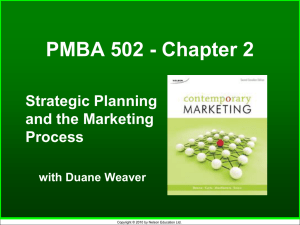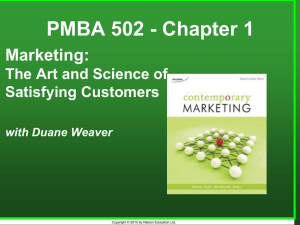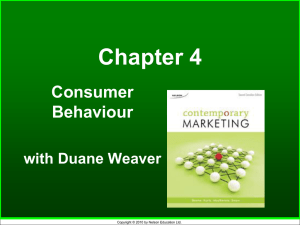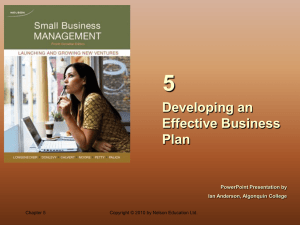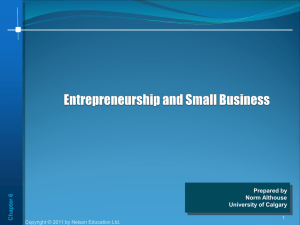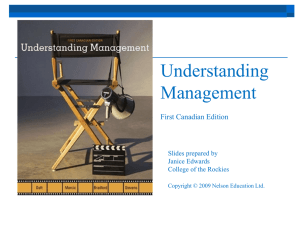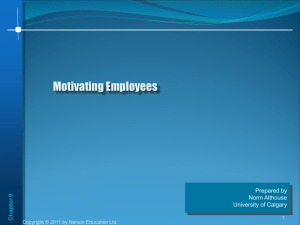Price Concepts Chp 17
advertisement
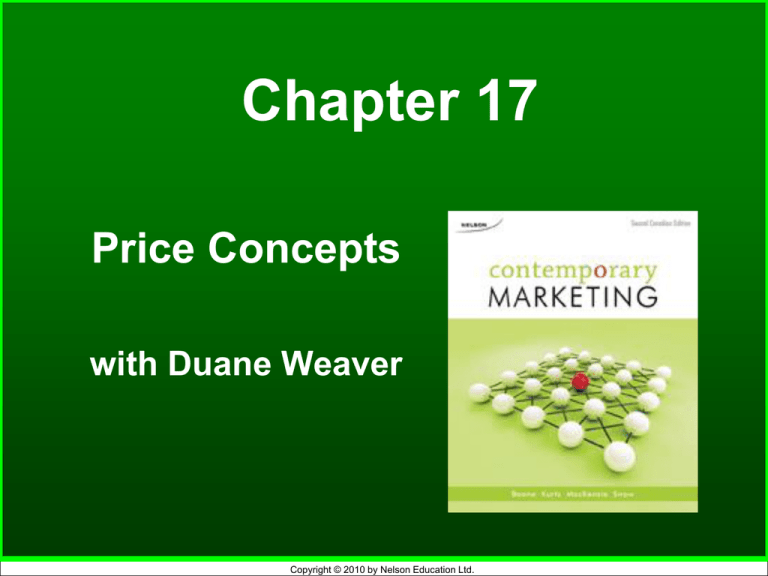
Chapter 17 Price Concepts with Duane Weaver Copyright © 2010 by Nelson Education Ltd. Outline 1. Price & the Law 2. Pricing Objectives 3. Profitability Objectives 4. Volume Objectives 5. Meeting Competition Objectives 6. Prestige Objectives 7. Determining Price 8. Elasticity and Pricing 9. Breakeven Analysis 10. Yield Management 11. Global Issues Copyright © 2010 Nelson Education Ltd. 17-2 Pricing and the Law • Price The exchange value of a good or service Competition Act • Federal legislation prohibiting price discrimination, price fixing, bid rigging, predatory pricing, false or misleading ordinary selling price representations, and other anti-competitive practices Copyright © 2010 Nelson Education Ltd. 17-3 Pricing Objectives Copyright © 2010 Nelson Education Ltd. 17-4 Profitability Objectives • Consumers must be convinced they are receiving good value for their money • Intense competition results from competition for leadership position • Basic formula for profit and revenue: Profit = Revenue ― Expenses Total Revenue = Price X Quantity Sold Copyright © 2010 Nelson Education Ltd. 17-5 The PIMS Studies • The Profit Impact of Market Strategies (PIMS) Project Research that discovered a strong positive relationship between a firm’s market share and product quality and its return on investment • Firms with market share more than 40 percent have average return on investment of 32 percent Explanation: Firms with large shares accumulate operating experience and lower overall costs relative to competitors with smaller market shares Copyright © 2010 Nelson Education Ltd. 17-6 Meeting Competition Objectives • Firms sometimes set prices to match industry leaders • Shifts marketing mix to focus on non-price factors Example: Some airlines focus competition on factors such as service and comfort • Value pricing Pricing strategy emphasizing the benefits derived from a product in comparison to the price and quality levels of competing offerings • Typically works best for relatively low-priced goods and services • Challenge is convincing customers that low-priced brands offer quality comparable to that of higherpriced product Copyright © 2010 Nelson Education Ltd. 17-7 Prestige Objectives • Prestige objectives Establishing a relatively high price to develop and maintain an image of quality and exclusiveness that appeals to status-conscious consumers Example: Tiffany jewellery Copyright © 2010 Nelson Education Ltd. 17-8 Methods for Determining Prices • Prices traditionally determined in two basic ways: 1. Supply and demand 2. Cost-oriented analysis • Customary prices Traditional prices that consumers expect to pay for a good or service • Companies try to balance consumer pricing expectations with the realities of rising costs Copyright © 2010 Nelson Education Ltd. 17-9 Cost and Revenue Curves • Product’s total cost = Total variable cost + total fixed cost • Variable costs change with the level of production • Include raw materials and labour costs • Fixed costs remain stable at any production level within a certain range • Include lease payments or insurance costs • Average total cost = (variable + fixed costs) / no. of units produced • Marginal cost Change in total cost that results from producing one additional unit of output Copyright © 2010 Nelson Education Ltd. 17-10 Price Determination using Marginal Analysis Price that brings the highest profit Copyright © 2010 Nelson Education Ltd. 17-11 The Concept of Elasticity in Pricing Strategy • Elasticity Measure of responsiveness of purchasers and suppliers to changes in price • Elasticity of demand Percentage change in the quantity of a good or service demanded divided by the percentage change in its price • Elasticity of supply Percentage change in the quantity of a good or service supplied divided by the percentage change in its price • Greater than 1.0 = elastic supply or demand • Less than 1.0 = inelastic supply or demand Example: 10 percent increase in cigarette prices results in 3 percent sales decline = inelastic Copyright © 2010 Nelson Education Ltd. 17-12 Determinants Of Elasticity • Availability of Substitutes or complements • If many are available, demand tends to be elastic • Role as complement to another product Example: Demand for motor oil is relatively inelastic • Increasing number of online business transactions • Increases demand elasticity as consumers have more choice • Whether product seen as necessity or luxury Example: Price change has little effect on gas demand • Portion of a person’s budget spent on an item Larger the portion, more elastic the demand • Demand often shows less elasticity in the short run than in the long run Copyright © 2010 Nelson Education Ltd. 17-13 Breakeven Chart Copyright © 2010 Nelson Education Ltd. 17-14 Yield Management • Yield Management Pricing strategy that allows marketers to vary prices based on such factors as demand, even though the cost of providing those goods or services remains the same Example: Varying prices for tickets to a play based on day, time, and seat location Example: Varying availability of restricted and nonrestricted airline tickets in the months and weeks before the flight to maximize revenues Copyright © 2010 Nelson Education Ltd. 17-15 Global Issues in Price Determination • Prices must support the firm’s broader goals • Use four strategies same as in domestic markets: • • • • • Profitability―if company is a price leader Volume―expose foreign markets to competition when trade barriers are lowered Meeting competition―important in Europe where common currency has led to price convergence Prestige―valid when products are associated with intangible benefits (quality, exclusivity, design) Also a fifth objective―price stability • Especially important for producers of commodities who are more susceptible to fluctuating prices than producers of value-oriented products Copyright © 2010 Nelson Education Ltd. 17-16
